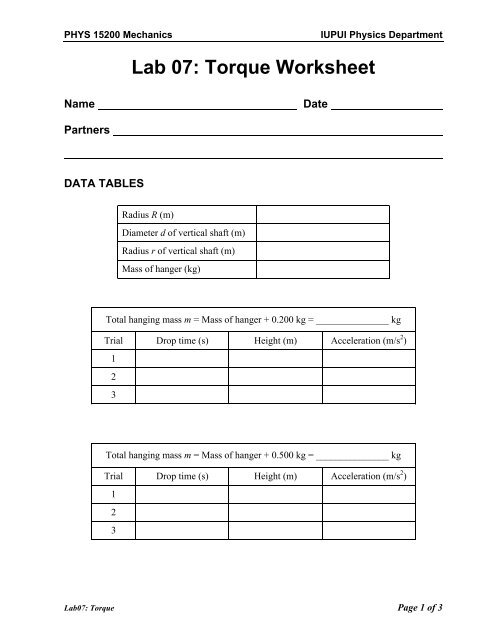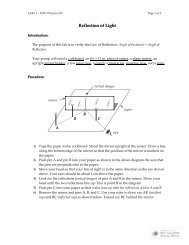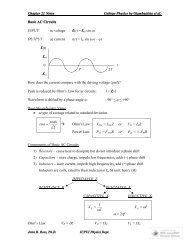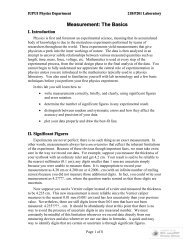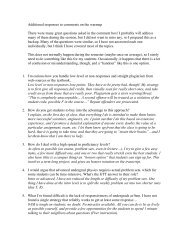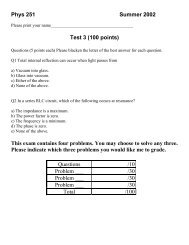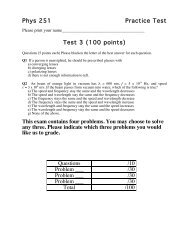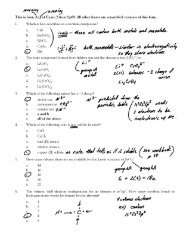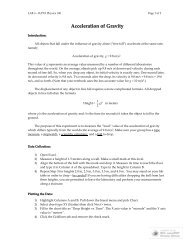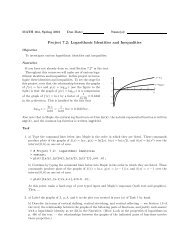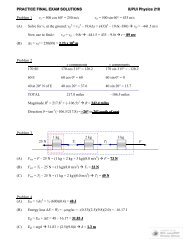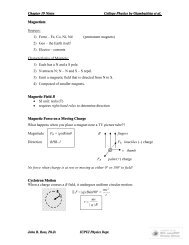Lab 07: Torque Worksheet - Web Physics - IUPUI
Lab 07: Torque Worksheet - Web Physics - IUPUI
Lab 07: Torque Worksheet - Web Physics - IUPUI
Create successful ePaper yourself
Turn your PDF publications into a flip-book with our unique Google optimized e-Paper software.
PHYS 15200 Mechanics<strong>IUPUI</strong> <strong>Physics</strong> Department<strong>Lab</strong> <strong>07</strong>: <strong>Torque</strong> <strong>Worksheet</strong>NameDatePartnersDATA TABLESRadius R (m)Diameter d of vertical shaft (m)Radius r of vertical shaft (m)Mass of hanger (kg)Total hanging mass m = Mass of hanger + 0.200 kg = _______________ kgTrial Drop time (s) Height (m) Acceleration (m/s 2 )123Total hanging mass m = Mass of hanger + 0.500 kg = _______________ kgTrial Drop time (s) Height (m) Acceleration (m/s 2 )123<strong>Lab</strong><strong>07</strong>: <strong>Torque</strong> Page 1 of 3
PHYS 15200 Mechanics<strong>IUPUI</strong> <strong>Physics</strong> DepartmentTotal hanging mass m = Mass of hanger + 0.800 kg = _______________ kgTrial Drop time (s) Height (m) Acceleration (m/s 2 )123Total hanging mass m = Mass of hanger + 1.100 kg = _______________ kgTrial Drop time (s) Height (m) Acceleration (m/s 2 )123ANALYSIS1. Calculate the average acceleration for each different hanging mass. Using the averageacceleration, compute the angular acceleration of the vertical shaft and the net torque actingon it due to the tension in the string:Hanging mass mAverage accelerationAngular accelerationNet torque(kg)(m/s 2 )(rad/s 2 )(N·m)2. Use Excel to plot the torque along the vertical axis and the angular acceleration along thehorizontal axis. Add a trendline and display its equation on the graph. Print the graph andstaple to this worksheet before you turn it in.Slope of graph = Measured moment of inertia = kg·m 2<strong>Lab</strong><strong>07</strong>: <strong>Torque</strong> Page 2 of 3
PHYS 15200 Mechanics<strong>IUPUI</strong> <strong>Physics</strong> Department3. Calculate the total moment of inertia of the two 200-g masses attached to the crossbar. Showyour calculations below:We are assuming that the moments of inertia of the vertical shaft and the crossbar arenegligible. Is this a reasonable assumption? Explain.4. Compute the percent error between the moment of inertias obtained in Questions 2 and 3.Take the value found in Question 3 as the accepted value.% error = %Would you say that the two values agree? Explain.<strong>Lab</strong><strong>07</strong>: <strong>Torque</strong> Page 3 of 3


